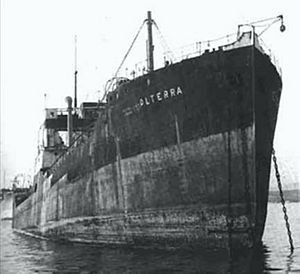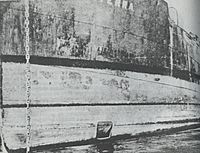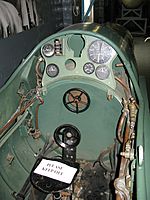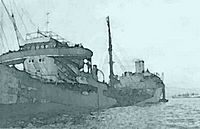Italian auxiliary ship Olterra facts for kids
Quick facts for kids Italian auxiliary ship Olterra |
|||||||
|---|---|---|---|---|---|---|---|
| Part of the Battle of the Mediterranean of World War II | |||||||
 Olterra at anchor shortly before being broken up at Vado Ligure, 1961 |
|||||||
|
|||||||
| Belligerents | |||||||
| Commanders and leaders | |||||||
| Lionel Crabb | Licio Visintini † Ernesto Notari |
||||||
| Strength | |||||||
| Harbour defences | 1 mother ship 9 manned torpedoes |
||||||
| Casualties and losses | |||||||
| 6 merchant ships sunk 2 sailors killed |
3 divers killed 3 prisoners 2 manned torpedoes lost |
||||||
The auxiliary ship Olterra was an Italian oil tanker. She was about 5,000 tons in size. Her crew sank her on purpose near Algeciras in the Bay of Gibraltar on June 10, 1940. This happened after Italy joined World War II. Later, in 1942, a special Italian naval unit called the Decima Flottiglia MAS secretly raised her. They used her as a hidden base for manned torpedoes. These torpedoes were used to attack Allied ships near Gibraltar.
Contents
Olterra Ship History
The Olterra was first built in 1913 in the United Kingdom. Her first name was Osage. In 1914, she was sold to the Standard Oil Company of New Jersey in New York and renamed Baton Rouge. She was sold again in 1925 and became Olterra. She had a few different owners before an Italian company bought her in 1930.
On June 10, 1940, Italy entered World War II. At that time, Olterra was in the Bay of Gibraltar near Algeciras, Spain. Her crew sank her to stop British forces from capturing her.
Secret Operations from Spain
From 1940 to 1942, there were several secret attacks on Gibraltar. Italian forces used submarines and combat swimmers. They sank or damaged many Allied ships, totaling about 40,000 tons.
Villa Carmela Base
After some attacks using submarines, the Italian special unit realized it would be better to have a secret base on land. They chose neutral Spain for this. An Italian officer, Antonio Ramognino, rented a house called Villa Carmela. It was right on the coast near Algeciras, facing a bay where Allied ships often anchored.
From July to September 1942, Italian frogmen used Villa Carmela as a base. They used limpet mines to sink or damage five merchant ships. The Olterra, even though she was half-sunk, helped by acting as a lookout post for these missions.
Refitting the Olterra
Another Italian officer, Lieutenant Licio Visintini, had an idea. He wanted to use the half-sunk Olterra as a secret base for their "maiali." "Maiali" was the Italian nickname for their manned torpedoes.
The Italians pretended they were raising the ship to sell it to a Spanish owner. A team of Italian special unit members, dressed as regular workers, took control of the tanker. They towed the ship to Algeciras for "repairs."
Once at the docks, the Italian team secretly changed some of Olterra's cargo areas and a boiler room. They turned them into a workshop to build and fix the manned torpedoes. They also set up a hidden lookout spot on the front of the ship. From here, they could watch the Bay of Gibraltar and the Allied ships.
The torpedo parts and other equipment were smuggled into Spain. They were hidden among materials for the "repairs" on Olterra. Finally, the team cut a secret sliding hatch six feet below the waterline. This was the hidden exit for the manned torpedoes. They would launch their attacks from a flooded area right under the workshop. This special unit was called Squadriglia Ursa Major.
First Secret Attack
By late 1942, Olterra was ready. All the secret supplies had arrived without anyone noticing. On December 6, 1942, a large group of British warships came into Gibraltar. This included battleships and aircraft carriers. Lieutenant Visintini planned an attack using three manned torpedoes. Each torpedo had two divers.
The attack started early on December 8. The first torpedo, with Visintini and Petty Officer Magro, reached the harbor defenses. British boats and guards were very alert. They dropped depth charges every few minutes. Visintini's torpedo was hit and destroyed. Their bodies were found later and buried with full military honors by the British.
The second torpedo was also spotted. After a long chase by anti-submarine boats, the Italian crew sank their torpedo. They then hid on an American ship and pretended to be regular sailors. They were captured by the British.
The last torpedo, with Cella and Leone, was caught in the alarm. But it managed to hide underwater. Leone went missing during the chase. Cella abandoned his torpedo, thinking he was far from Gibraltar. He surfaced and found himself just a few meters from Olterra. His torpedo was recovered the next day. The captured divers told the British the attack came from a submarine, which tricked Allied intelligence. However, this first mission from Olterra was not successful.
Second Secret Attack
After Visintini's death, Lieutenant Ernesto Notari took charge of the Ursa Major unit on Olterra. New people and supplies arrived from Italy. The British had improved their harbor defenses. So, the next missions targeted transport and cargo ships anchored outside the main naval base.
On the night of May 8, 1943, Lieutenant Notari led another three-torpedo attack. The weather was bad, which helped hide their movements. The targets were merchant ships anchored far from Algeciras. The strong winds made it hard to attach the mines to the ships.
By dawn, all the Italian torpedoes returned safely to Olterra. They had mined three ships: the American Pat Harrison (7,000 tons), and the British Mahsud (7,500 tons) and Camerata (4,875 tons). When the mines exploded, the Pat Harrison was badly damaged and could not be repaired. One American sailor died. The Mahsud sank but part of it stayed above water. The Camerata sank completely. To make the British think combat swimmers did it, the Italians scattered diving gear along the shore. This second attack from Olterra was a great success.
Last Mission
On July 25, 1943, Italy's leader, Mussolini, was removed from power. This showed that Italy was close to losing the war. But the Decima MAS unit kept planning attacks. On August 3, 1943, the Ursa Major carried out its last mission against Gibraltar.
Again, three torpedoes left Olterra to find three transport ships. Notari led the torpedoes close to the Spanish coast to avoid searchlights. His partner, Andrea Gianoli, was not very experienced. While they were attaching an explosive charge to a ship, their torpedo went out of control. It suddenly dove very deep.
The torpedo then surfaced just a few feet from their target. Notari was half-conscious and his partner was gone. He tried to fix the torpedo, but it was broken. He managed to escape at full speed, helped by a group of porpoises that hid his path. Gianoli was left behind. After waiting two hours on the ship's rudder, he called for help.
A British motor launch arrived with a diver from Lieutenant Crabb's team. It was clear the ship, the American Harrison Grey Otis, had been mined. The mine exploded just seconds before the British diver could enter the water. One sailor died, and eight others were badly hurt. Like another ship in May, the Otis (7,700 tons) was too damaged to be repaired.
Two other Allied ships also exploded around the same time. The Norwegian ship Thorshøvdi (9,900 tons) broke in half. The British ship Stanridge (6,000 tons) sank in shallow water. The last mission of the Ursa Major destroyed 23,000 tons of Allied shipping.
After the War
Italy surrendered to the Allies on September 8, 1943. For Olterra, the war was over. Before this, the British in Gibraltar had no real proof that the Olterra was involved in the attacks. As one British officer, Leon Goldsworthy, said:
We never found any proof of the part played by the Olterra in this affair. From British Naval Headquarters on Gibraltar we could see, with the naked eye, the Olterra’s superstructure above the exterior mole at Algeciras. The possibility that the Olterra might be associated in some way with the attacks of human torpedoes did not escape us, but there was never the least visible evidence to suggest the actual nature of her participation.
The Spanish authorities tried to hide the evidence. But when Crabb’s diving team boarded Olterra after Italy surrendered, they found parts from three different torpedoes. They were able to put together a full manned torpedo, which they named Emily. This torpedo was later lost during trials at sea. After the war, Crabb even met some of his former enemies, including Lieutenant Notari.
Olterra Relics
The ship was taken apart in 1961. But some pieces of her outer metal, with her name on them, and a few portholes were saved. They are now on display at the Italian Naval Museum in La Spezia. Other items from the Decima Flotilla MAS, like an explosive motorboat and a manned torpedo, are also there.
See also
- Decima MAS
- Human torpedo
- Military history of Gibraltar during World War II
- Spain in World War II
Sources
- Borghese, Valerio (1995). Sea Devils: Italian Navy Commandos in World War II. Naval Institute Press. ISBN: 1-55750-072-X.
- Bragadin, Marc'Antonio (1957). The Italian Navy in World War II, United States Naval Institute, Annapolis. ISBN: 0-405-13031-7.
- Breuer, William (2001). Daring Missions of World War II. J. Wiley. ISBN: 0-471-40419-5
- Cocchia, Aldo (1958). The hunters and the hunted. United States Naval Institute, Annapolis. ISBN: 0-405-13030-9.
- Greene, Jack & Massignani, Alessandro (2004).The Black Prince and the Sea Devils: The Story of Valerio Borghese and the Elite Units of the Decima MAS. Da Capo Press. ISBN: 0-306-81311-4.
- Longo, Luigi Emilio (1991). "Reparti speciali" italiani nella seconda guerra mondiale: 1940-1943. Mursia. ISBN: 88-425-0734-2.
- O'Donnell, Patrick K. (2006). Operatives, Spies, and Saboteurs: The Unknown Story of World War II's OSS. Kensington Publishing Corporation. ISBN: 0-8065-2798-6
- Pugh, Marshall (1956). Frogman: Commander Crabb's Story. Scribner.
- Schofield, Williams, Carisella P. (2004). Frogmen: First Battles. Branden Books. ISBN: 0-8283-2088-8.




